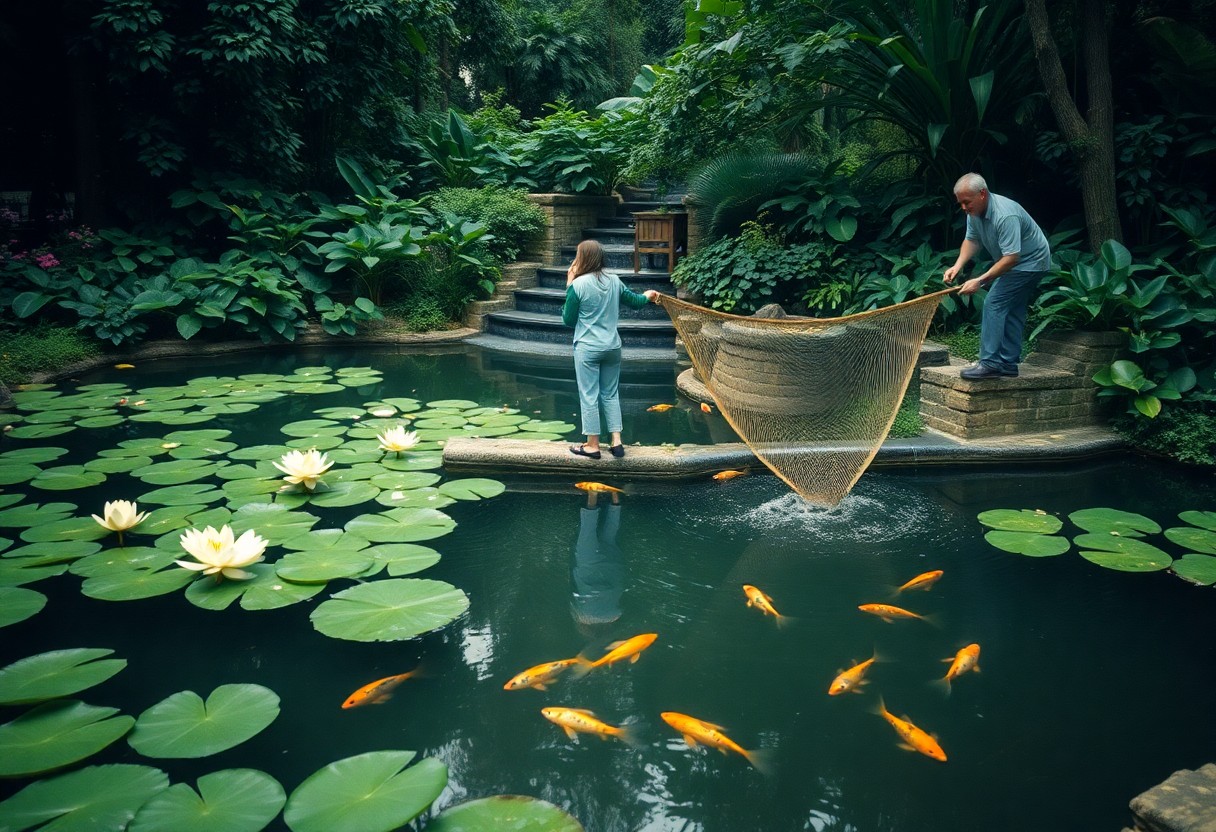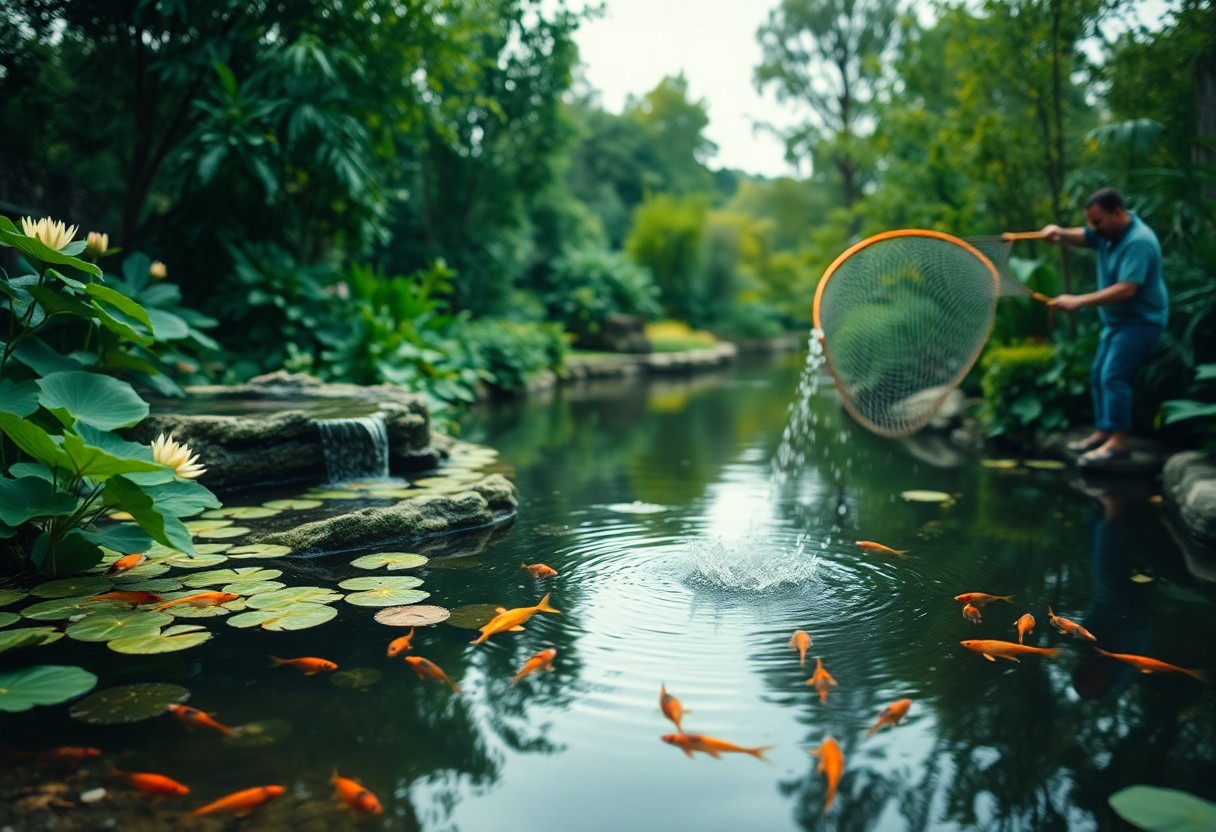There’s a natural way to maintain your pond’s balance without resorting to harmful chemicals. By employing simple techniques, you can keep your water clear, promote a healthy ecosystem, and protect your fish and plants. Using natural filtration methods, introducing beneficial organisms, and practicing regular maintenance will enhance your pond’s beauty while ensuring its safety. In this guide, you’ll discover effective strategies to keep your pond sparkling clean and environmentally friendly.
Table of Contents
Key Takeaways:
- Regularly remove debris and organic waste such as leaves and algae to prevent stagnation and nutrient build-up.
- Introduce beneficial bacteria and enzymes that help break down organic matter naturally, promoting a healthy ecosystem.
- Use physical barriers like nets to keep debris from entering the pond and utilize sediment traps to minimize sludge accumulation.
- Incorporate aquatic plants that provide shade and absorb excess nutrients, balancing the pond’s ecosystem.
- Consider installing a natural filtration system, such as a waterfall or biofilter, to enhance water circulation and filtration without chemicals.
Understanding Pond Ecosystem
To maintain a clean and healthy pond, it’s vital to understand its ecosystem. Your pond is not just a body of water; it comprises various living organisms that interact with each other. By recognizing how these components work, you can make informed choices about how to keep your pond clean naturally. This knowledge sets the foundation for creating a harmonious environment where plants and animals thrive.
Natural Balance Components
To achieve a balanced pond ecosystem, you need to focus on several key components, including beneficial bacteria, aquatic plants, and wildlife. These elements work together to break down waste, absorb excess nutrients, and provide habitat for fish and other organisms. By promoting a natural balance within your pond, you can enhance water quality and reduce the need for chemical interventions.
Common Pollutants and Their Sources
Little do many realize that pollutants can infiltrate your pond from various sources, such as runoff from nearby lawns, overflowing trash cans, or even poorly maintained septic systems. These contaminants can lead to excessive algae growth and harm aquatic life, ultimately disrupting your pond’s ecosystem.
Plus, understanding the types of contaminants that pose a risk to your pond is vital for effective maintenance. Fertilizers from landscaping can wash into your pond and cause nutrient overload, leading to algae blooms. Similarly, sediment from disturbed soil can cloud your water, blocking sunlight needed for aquatic plants. Detergents from household runoff can also introduce harmful chemicals. By being aware of these pollutants and their sources, you can take proactive steps to minimize their impact and ensure your pond remains a healthy, vibrant ecosystem.

Natural Filtration Methods
If you want to keep your pond clean naturally, consider implementing various natural filtration methods. Utilizing these techniques not only helps maintain water quality but can also enhance the beauty of your pond. Natural Pond Maintenance: How To Keep Your Pond Healthy offers insight into effective ways you can achieve a chemical-free environment for your aquatic ecosystem.
Beneficial Plants and Aquatic Vegetation
Even small roots and leaves can significantly improve water quality in your pond. Incorporating beneficial plants like water lilies, cattails, and hornwort not only aids in filtration but also provides habitats for various wildlife. These plants absorb excess nutrients and help maintain a balanced ecosystem, which is imperative for a thriving pond.
Biological Filtration Systems
Natural biological filtration systems utilize beneficial bacteria to break down harmful substances in your pond. These systems create a self-sustaining cycle that enhances water clarity and quality. By introducing microbial populations into your pond, you can establish an effective filtration process that reduces toxic waste and promotes overall health.
A biological filtration system works by introducing beneficial bacteria into your pond, which consume organic matter and convert harmful substances into less toxic compounds. This process encourages a natural balance and thrives on the presence of aerobic bacteria, which are vital for breaking down waste. By investing in a suitable filtration system, you can maintain clean water while ensuring your pond’s ecosystem flourishes, all without the need for synthetic chemicals.
Preventive Maintenance Tips
After establishing a clean pond environment, it’s vital to maintain it through regular preventive maintenance. Here are some key tips:
- Regularly remove debris such as fallen leaves and twigs
- Monitor aquatic plants’ growth and trim as necessary
- Encourage beneficial organisms like snails or tadpoles
- Ensure your pond is well-aerated to support healthy water circulation
- Limit fish feeding to prevent excess waste
Perceiving these steps will help sustain a thriving aquatic ecosystem.
Regular Cleaning Schedule
You should establish a cleaning schedule that allows you to regularly clear your pond of debris while monitoring its overall health. Frequent routine checks can help you tackle small issues before they evolve into larger problems, keeping your ecosystem balanced and vibrant.
Water Level Management
Water management in your pond is important for maintaining a healthy balance. Ensure that you regularly check and regulate your water levels to prevent stagnation and allow adequate oxygenation, promoting a thriving environment for aquatic life.
With effective water level management, you can avoid situations that lead to algae blooms and decreased aquatic life. Maintaining an optimal water level helps ensure the right oxygen levels, which are vital for fish and plant health. Make sure to top off your pond during dry spells and monitor for any excessive evaporation. Keeping an eye on your water levels will protect your pond from becoming a breeding ground for undesirable substances, ultimately enhancing the health of your ecosystem.
Physical Cleaning Techniques
Keep your pond thriving by implementing effective physical cleaning techniques. Regular maintenance helps ensure a healthy ecosystem without relying on harmful chemicals. For detailed strategies, check out How to Keep Pond Water Clean and Healthy: Seven Pro Tips.
Bottom Debris Removal
An imperative aspect of maintaining your pond’s health is removing accumulated debris from the bottom. This can be achieved using a pond vacuum or net, which helps eliminate organic matter and sediment that can decompose and release harmful toxins into the water.
Surface Skimming Methods
Skimming the surface of your pond is effective for removing floating debris, leaves, and algae. Investing in a good surface skimmer or using a net can help maintain clarity and improve the overall aesthetics of your pond.
The surface skimming method is vital because it not only removes unwanted debris but also prevents algae growth by limiting the nutrients available for their development. You should regularly check this layer since built-up organic material can lead to unfavorable water conditions. By keeping the surface clear, you enhance the beauty of your pond while supporting a healthy aquatic ecosystem.
Natural Water Treatment Solutions
Now, when it comes to keeping your pond clean without resorting to harmful chemicals, you have several natural water treatment solutions at your disposal. These methods are not only eco-friendly, but they also promote a healthy ecosystem within your pond. By incorporating beneficial elements and practices, you can maintain clear water and support a balanced environment for fish and plants.
Beneficial Bacteria Applications
One effective way to enhance your pond’s health is by using beneficial bacteria applications. These naturally occurring bacteria help break down organic matter, such as leaves and algae, in your pond. By introducing these microorganisms, you can significantly reduce the buildup of detritus and create a more balanced environment for aquatic life.
Natural Clarifiers
Even better, consider utilizing natural clarifiers to help maintain clean water in your pond. These products work by promoting the growth of beneficial microbes that can effectively clarify your water. By harnessing the power of nature, you can achieve a pristine pond without the need for harsh chemicals.
A variety of natural clarifiers are available, including barley straw and microbial solutions. Barley straw releases compounds that inhibit algae growth as it decomposes, making it an excellent option for controlling unwanted blooms. Microbial solutions introduce specific microorganisms that improve water clarity by breaking down organic debris and excess nutrients. Using these natural clarifiers not only improves water clarity but also enhances the overall health of your pond by promoting a stable ecosystem. Keep in mind that the success of these clarifiers depends on pond’s specific conditions, so it’s crucial to monitor and adjust as necessary.
Seasonal Pond Care
All year round, maintaining your pond remains important for a healthy ecosystem. Seasonal pond care involves specific actions that support the unique challenges posed by each time of year. By effectively managing your pond through the seasons, you can ensure the water stays clear, and your aquatic life thrives.
Spring and Summer Maintenance
Little efforts during the warmer months can lead to a vibrant pond. Focus on removing any decaying debris and consider introducing beneficial plants that provide shade to keep water temperatures down and prevent algae growth. Regular monitoring of water quality and maintaining filtration systems will also support a clean environment.
Fall and Winter Preparations
Even as temperatures drop, your pond still requires attention. Clear away fallen leaves and debris that can decompose and pollute the water. Additionally, consider implementing a pond heater or aerator to prevent icing over, which can suffocate your fish if they cannot access oxygen.
Another important aspect of pond care during the colder months is to ensure that the fish have a healthy environment. Remove any harmful debris that can rot and introduce bacteria, and check your water quality regularly to prevent the buildup of harmful substances. You should also make sure that the pond is not completely frozen, as a thin layer of ice can still allow for gas exchange, but an entire freeze may trap harmful gases beneath the surface, endangering your aquatic life.
To wrap up
Hence, by incorporating natural methods such as regular maintenance, the use of beneficial bacteria, and encouraging a balanced ecosystem, you can effectively keep your pond clean without resorting to chemicals. Implementing practices like removing debris, controlling algae, and introducing aquatic plants will not only improve the water quality but also enhance the beauty of your pond. By taking these steps, you ensure a healthier environment for your pond’s inhabitants and enjoy a serene outdoor space for years to come.
FAQ
Q: Why is it important to keep my pond clean without chemicals?
A: Keeping your pond clean without chemicals is necessary for maintaining a healthy ecosystem. Chemicals can disrupt the natural balance of microorganisms, harm aquatic life, and negatively affect water quality. Natural methods help preserve biodiversity and create a safe environment for plants and animals.
Q: What are some effective natural methods to keep my pond clean?
A: There are several natural methods to maintain pond cleanliness. These include adding beneficial bacteria that break down organic waste, installing aquatic plants that absorb excess nutrients, and using aeration techniques to improve oxygen levels. Implementing a balanced ecosystem with fish and other fauna also helps to control algae growth.
Q: How can I prevent algae growth in my pond?
A: Preventing algae growth involves controlling nutrient levels and maintaining good water circulation. You can achieve this by limiting the use of fertilizers around the pond, planting submerged and floating plants to absorb nutrients, and ensuring proper aeration. Additionally, certain fish species, like koi or goldfish, can help eat algae and maintain balance.
Q: What role do aquatic plants play in maintaining pond cleanliness?
A: Aquatic plants serve multiple purposes in promoting pond health. They absorb excess nutrients, provide shade that reduces sunlight (which can lead to algae blooms), and offer habitat for beneficial microorganisms and fish. By incorporating a variety of plants, you can create a natural filtration system that keeps the water clear and clean.
Q: How often should I perform maintenance tasks in my pond?
A: Regular maintenance is key to a clean pond. Tasks such as removing debris, checking water levels, and inspecting plants should be conducted weekly. Seasonal maintenance, such as pruning and dividing plants or cleaning filters, can be done quarterly. Regular observation will help you catch potential issues early and keep the ecosystem thriving.

